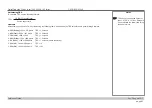
page 81
Digital Projection E-Vision Laser 7500, 8500 & 10K Series
Reference Guide
CHOOSING A LENS
Rev D August 2017
Choosing A Lens
A number of lenses are available. Which lens you choose depends on the screen size, image aspect ratio, throw distance and light output.
The following table shows all available lenses in order of their
throw ratios
:
Throw ratios
Focus range
Lens shift
0.82 m - 2.71 m
none
1.02 m - 12.7 m
V: 0.5 (U) 0 (D) frame
H: 0.1 (L) 0.1 (R) frame
0.81 m - 5.08 m
none
1.33 m - 11.73 m
V: 0.5 (U) 0 (D) frame
H: 0.1 (L) 0.1 (R) frame
1.83 m - 14.9 m
V: 0.5 (U) 0 (D) frame
H: 0.1 (L) 0.1 (R) frame
2.36 m - 24.2 m
V: 0.5 (U) 0 (D) frame
H: 0.1 (L) 0.1 (R) frame
3.8 m - 35.35 m
V: 0.5 (U) 0 (D) frame
H: 0.1 (L) 0.1 (R) frame
0.38 : 1 fixed (UST)
0.75 - 0.93 : 1 zoom
0.76 : 1 fixed
1.25 - 1.79 : 1 zoom
1.7
3
- 2.27 : 1 zoom
2.22 - 3.67 : 1 zoom
3.58 - 5.38 : 1 zoom
5.31 - 8.26 : 1 zoom
5.59 m - 54.8 m
V: 0.5 (U) 0 (D) frame
H: 0.1 (L) 0.1 (R) frame
To choose a lens, calculate the
throw ratio
required.
Notes
Throw distance calculations are
based on the distance from the outer
end of the lens, which will vary from
lens to lens.
The distance between the front
of the projector chassis and the
outer end of the lens is called
lens
extension
. Lens extensions is
measured when the lens is focused
at infinity, and fully extended.
Refer to the projector CAD drawings
for individual lens extension figures.
The
0.38 : 1 fixed lens
has no
adjustable shift value. However,
the lens has an inherent offset
depending on image size. See
the UST documentation published
separately on the Digital Projection
website.
The
0.75 - 0.93 : 1 zoom lens
has
an additional feature permitting
barrel correction for curved screens.
The front ring of the lens is a
manual control which provides focus
curvature adjustment to correct for
the different focal distances between
center and corner.
For information about individual lens
the end of this document.
















































